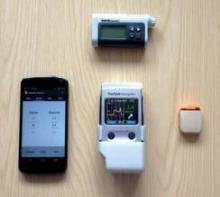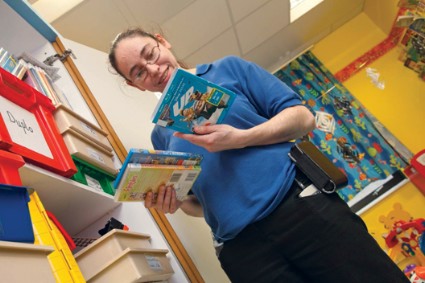User login
SAN FRANCISCO – Unsupervised home use of a closed-loop insulin delivery system by patients with type 1 diabetes proved to be feasible and acceptable to patients and seemed to improve glucose control in two small prospective, randomized crossover studies.
The results move development of a potential artificial pancreas one step forward, though much work remains before one ever becomes commercially available.
Both of the multicenter European studies of insulin-dependent adults with type 1 diabetes – one with 24 participants and the other with 17 participants – compared the same experimental closed-loop insulin delivery system (the FlorenceD2 system) with a control treatment that used sensor-augmented insulin pump therapy.
In one study of overnight use, patients using the closed-loop system spent a mean of 53% of nights (midnight to 7 a.m.) with their glucose levels in the target range of 3.9-8.0 mmol/L (70-144 mg/dL), compared with 39% of nights while on the control therapy, a significant difference. In the other study of both day and night use, glucose levels were in the target ranges (3.9-10 mmol/L during the day or 3.9-8 mmol/L at night) for 73% of days and 48% of nights on the closed-loop system, significantly longer than with the control treatment (65% and 35%, respectively).
Investigators reported the findings in separate presentations at the annual scientific sessions of the American Diabetes Association.
The 24-patient night-use study randomized patients to the intervention or control therapy for 4 weeks, then had them switch to the other therapy for 4 weeks. Before taking the closed-loop system home, patients spent one night at a clinical research center for training and to assess their competency to use the automated system.
The proportion of nighttime with hyperglycemia (glucose levels above the 144 mg/dL upper limit of the target range) was significantly lower while on the closed-loop system (44%) than on the control therapy (57%), reported Dr. Hood Thabit of the University of Cambridge (England) and his associates. The proportion of nighttime with hypoglycemia did not differ significantly between groups.
Mean overnight glucose levels were significantly lower while on the closed-loop system (148 mg/dL) than on the control therapy (162 mg/dL), as were mean 24-hour glucose levels (157 mg/dL vs. 167 mg/dL, respectively), the intention-to-treat analysis showed.
Two episodes of severe hypoglycemia occurred while on the closed-loop system, one due to user error and the other for unknown reasons. Both patients made a full recovery, Dr. Thabit said.
The closed-loop system was interrupted unintentionally an average of once every 5 nights, which one physician in the audience called "very impressive."
The separate day-and-night study of 17 adults randomized them to 8 days of either therapy followed by a 1- to 3-week washout period and then 8 days on the other therapy. Again, patients received a day of training at a research facility before using the closed-loop system at home.
During the 7 days of home use with the closed-loop system, patients spent significantly less time in hyperglycemia (levels above 10 mmol/L), compared with the control therapy (21% vs. 30% of the time, respectively), reported Dr. Lalantha Leelarathna, also of the University of Cambridge. Time spent in hypoglycemia did not differ significantly between groups.
Mean glucose levels were significantly lower while patients were on the closed-loop system (8.1 mmol/L) than on the sensor-augmented pump (8.8 mmol/L), he said.
The closed-loop system was interrupted unintentionally every 12 hours on average, mainly because the pump was not connected, the continuous glucose monitor was unavailable, or the user changed pump settings. Two severe hypoglycemic episodes occurred, one during use of the closed-loop system and one during the crossover period. Both patients recovered fully. Four episodes of high glucose because of failure of the insulin infusion set did not lead to ketosis or hospitalization.
"We need to improve portability and connectivity between devices," Dr. Leelarathna said.
The Artificial Pancreas at Home (AP@home) consortium next will test the system in a 3-monthy study of day-and-night use by 30 adults with type 1 diabetes, compared with optimized sensor-augmented pump therapy, Dr. Leelarathna said.
Previous studies conducted exclusively in clinical research facilities have shown that closed-loop insulin delivery systems can improve glucose control, but these are among the first studies to show that they may do the same when used by patients at home.
Dr. Leelarathna and Dr. Thabit reported having no financial disclosures.
On Twitter @sherryboschert
This is obviously very exciting. Clearly, there are things to be worked out in terms of glucagon, and in general about pump sites (whether it’s insulin or glucagon). We have seen that patients who have been on pumps for 20-25 years get into real problems with their infusion site. The sites get scarred and fibrosed, and absorption becomes poor. I’m concerned about that. We need to do a better job in learning why that is and how we can address the challenges we have with pump sites. That’s a concern that hopefully will be fixable.
There’s a bigger concern here. We’re beginning to add more technology that is certainly going to help people with type 1 diabetes, but who is going to pay for it? Where I live, I am having a very difficult time getting payers to pay for the sensor, let alone what’s going to be required with all of the extra paraphernalia that’s going to come with the sensor and controller. And with the cost of insulin, because we have moved into this accountable care organization culture and mentality, I’m having a hard time even getting insulin for some of these patients. This includes the type 1 diabetes patients.
There’s such a disconnect between what we’re seeing at this meeting and my day-to-day and hour-to-hour struggles with the payers. I get very concerned about how we’re going to connect those dots. My big concern is not the science, not the fact that the technology is improving, but how we are going to pay for it, given how our environment has been changing.
Irl Hirsch, M.D., is professor of medicine and chair of diabetes treatment and teaching at the University of Washington, Seattle. He gave these comments in an interview. Dr. Hirsch reported financial associations with Sanofi, Halozyme, Abbott Laboratories, and Roche.
This is obviously very exciting. Clearly, there are things to be worked out in terms of glucagon, and in general about pump sites (whether it’s insulin or glucagon). We have seen that patients who have been on pumps for 20-25 years get into real problems with their infusion site. The sites get scarred and fibrosed, and absorption becomes poor. I’m concerned about that. We need to do a better job in learning why that is and how we can address the challenges we have with pump sites. That’s a concern that hopefully will be fixable.
There’s a bigger concern here. We’re beginning to add more technology that is certainly going to help people with type 1 diabetes, but who is going to pay for it? Where I live, I am having a very difficult time getting payers to pay for the sensor, let alone what’s going to be required with all of the extra paraphernalia that’s going to come with the sensor and controller. And with the cost of insulin, because we have moved into this accountable care organization culture and mentality, I’m having a hard time even getting insulin for some of these patients. This includes the type 1 diabetes patients.
There’s such a disconnect between what we’re seeing at this meeting and my day-to-day and hour-to-hour struggles with the payers. I get very concerned about how we’re going to connect those dots. My big concern is not the science, not the fact that the technology is improving, but how we are going to pay for it, given how our environment has been changing.
Irl Hirsch, M.D., is professor of medicine and chair of diabetes treatment and teaching at the University of Washington, Seattle. He gave these comments in an interview. Dr. Hirsch reported financial associations with Sanofi, Halozyme, Abbott Laboratories, and Roche.
This is obviously very exciting. Clearly, there are things to be worked out in terms of glucagon, and in general about pump sites (whether it’s insulin or glucagon). We have seen that patients who have been on pumps for 20-25 years get into real problems with their infusion site. The sites get scarred and fibrosed, and absorption becomes poor. I’m concerned about that. We need to do a better job in learning why that is and how we can address the challenges we have with pump sites. That’s a concern that hopefully will be fixable.
There’s a bigger concern here. We’re beginning to add more technology that is certainly going to help people with type 1 diabetes, but who is going to pay for it? Where I live, I am having a very difficult time getting payers to pay for the sensor, let alone what’s going to be required with all of the extra paraphernalia that’s going to come with the sensor and controller. And with the cost of insulin, because we have moved into this accountable care organization culture and mentality, I’m having a hard time even getting insulin for some of these patients. This includes the type 1 diabetes patients.
There’s such a disconnect between what we’re seeing at this meeting and my day-to-day and hour-to-hour struggles with the payers. I get very concerned about how we’re going to connect those dots. My big concern is not the science, not the fact that the technology is improving, but how we are going to pay for it, given how our environment has been changing.
Irl Hirsch, M.D., is professor of medicine and chair of diabetes treatment and teaching at the University of Washington, Seattle. He gave these comments in an interview. Dr. Hirsch reported financial associations with Sanofi, Halozyme, Abbott Laboratories, and Roche.
SAN FRANCISCO – Unsupervised home use of a closed-loop insulin delivery system by patients with type 1 diabetes proved to be feasible and acceptable to patients and seemed to improve glucose control in two small prospective, randomized crossover studies.
The results move development of a potential artificial pancreas one step forward, though much work remains before one ever becomes commercially available.
Both of the multicenter European studies of insulin-dependent adults with type 1 diabetes – one with 24 participants and the other with 17 participants – compared the same experimental closed-loop insulin delivery system (the FlorenceD2 system) with a control treatment that used sensor-augmented insulin pump therapy.
In one study of overnight use, patients using the closed-loop system spent a mean of 53% of nights (midnight to 7 a.m.) with their glucose levels in the target range of 3.9-8.0 mmol/L (70-144 mg/dL), compared with 39% of nights while on the control therapy, a significant difference. In the other study of both day and night use, glucose levels were in the target ranges (3.9-10 mmol/L during the day or 3.9-8 mmol/L at night) for 73% of days and 48% of nights on the closed-loop system, significantly longer than with the control treatment (65% and 35%, respectively).
Investigators reported the findings in separate presentations at the annual scientific sessions of the American Diabetes Association.
The 24-patient night-use study randomized patients to the intervention or control therapy for 4 weeks, then had them switch to the other therapy for 4 weeks. Before taking the closed-loop system home, patients spent one night at a clinical research center for training and to assess their competency to use the automated system.
The proportion of nighttime with hyperglycemia (glucose levels above the 144 mg/dL upper limit of the target range) was significantly lower while on the closed-loop system (44%) than on the control therapy (57%), reported Dr. Hood Thabit of the University of Cambridge (England) and his associates. The proportion of nighttime with hypoglycemia did not differ significantly between groups.
Mean overnight glucose levels were significantly lower while on the closed-loop system (148 mg/dL) than on the control therapy (162 mg/dL), as were mean 24-hour glucose levels (157 mg/dL vs. 167 mg/dL, respectively), the intention-to-treat analysis showed.
Two episodes of severe hypoglycemia occurred while on the closed-loop system, one due to user error and the other for unknown reasons. Both patients made a full recovery, Dr. Thabit said.
The closed-loop system was interrupted unintentionally an average of once every 5 nights, which one physician in the audience called "very impressive."
The separate day-and-night study of 17 adults randomized them to 8 days of either therapy followed by a 1- to 3-week washout period and then 8 days on the other therapy. Again, patients received a day of training at a research facility before using the closed-loop system at home.
During the 7 days of home use with the closed-loop system, patients spent significantly less time in hyperglycemia (levels above 10 mmol/L), compared with the control therapy (21% vs. 30% of the time, respectively), reported Dr. Lalantha Leelarathna, also of the University of Cambridge. Time spent in hypoglycemia did not differ significantly between groups.
Mean glucose levels were significantly lower while patients were on the closed-loop system (8.1 mmol/L) than on the sensor-augmented pump (8.8 mmol/L), he said.
The closed-loop system was interrupted unintentionally every 12 hours on average, mainly because the pump was not connected, the continuous glucose monitor was unavailable, or the user changed pump settings. Two severe hypoglycemic episodes occurred, one during use of the closed-loop system and one during the crossover period. Both patients recovered fully. Four episodes of high glucose because of failure of the insulin infusion set did not lead to ketosis or hospitalization.
"We need to improve portability and connectivity between devices," Dr. Leelarathna said.
The Artificial Pancreas at Home (AP@home) consortium next will test the system in a 3-monthy study of day-and-night use by 30 adults with type 1 diabetes, compared with optimized sensor-augmented pump therapy, Dr. Leelarathna said.
Previous studies conducted exclusively in clinical research facilities have shown that closed-loop insulin delivery systems can improve glucose control, but these are among the first studies to show that they may do the same when used by patients at home.
Dr. Leelarathna and Dr. Thabit reported having no financial disclosures.
On Twitter @sherryboschert
SAN FRANCISCO – Unsupervised home use of a closed-loop insulin delivery system by patients with type 1 diabetes proved to be feasible and acceptable to patients and seemed to improve glucose control in two small prospective, randomized crossover studies.
The results move development of a potential artificial pancreas one step forward, though much work remains before one ever becomes commercially available.
Both of the multicenter European studies of insulin-dependent adults with type 1 diabetes – one with 24 participants and the other with 17 participants – compared the same experimental closed-loop insulin delivery system (the FlorenceD2 system) with a control treatment that used sensor-augmented insulin pump therapy.
In one study of overnight use, patients using the closed-loop system spent a mean of 53% of nights (midnight to 7 a.m.) with their glucose levels in the target range of 3.9-8.0 mmol/L (70-144 mg/dL), compared with 39% of nights while on the control therapy, a significant difference. In the other study of both day and night use, glucose levels were in the target ranges (3.9-10 mmol/L during the day or 3.9-8 mmol/L at night) for 73% of days and 48% of nights on the closed-loop system, significantly longer than with the control treatment (65% and 35%, respectively).
Investigators reported the findings in separate presentations at the annual scientific sessions of the American Diabetes Association.
The 24-patient night-use study randomized patients to the intervention or control therapy for 4 weeks, then had them switch to the other therapy for 4 weeks. Before taking the closed-loop system home, patients spent one night at a clinical research center for training and to assess their competency to use the automated system.
The proportion of nighttime with hyperglycemia (glucose levels above the 144 mg/dL upper limit of the target range) was significantly lower while on the closed-loop system (44%) than on the control therapy (57%), reported Dr. Hood Thabit of the University of Cambridge (England) and his associates. The proportion of nighttime with hypoglycemia did not differ significantly between groups.
Mean overnight glucose levels were significantly lower while on the closed-loop system (148 mg/dL) than on the control therapy (162 mg/dL), as were mean 24-hour glucose levels (157 mg/dL vs. 167 mg/dL, respectively), the intention-to-treat analysis showed.
Two episodes of severe hypoglycemia occurred while on the closed-loop system, one due to user error and the other for unknown reasons. Both patients made a full recovery, Dr. Thabit said.
The closed-loop system was interrupted unintentionally an average of once every 5 nights, which one physician in the audience called "very impressive."
The separate day-and-night study of 17 adults randomized them to 8 days of either therapy followed by a 1- to 3-week washout period and then 8 days on the other therapy. Again, patients received a day of training at a research facility before using the closed-loop system at home.
During the 7 days of home use with the closed-loop system, patients spent significantly less time in hyperglycemia (levels above 10 mmol/L), compared with the control therapy (21% vs. 30% of the time, respectively), reported Dr. Lalantha Leelarathna, also of the University of Cambridge. Time spent in hypoglycemia did not differ significantly between groups.
Mean glucose levels were significantly lower while patients were on the closed-loop system (8.1 mmol/L) than on the sensor-augmented pump (8.8 mmol/L), he said.
The closed-loop system was interrupted unintentionally every 12 hours on average, mainly because the pump was not connected, the continuous glucose monitor was unavailable, or the user changed pump settings. Two severe hypoglycemic episodes occurred, one during use of the closed-loop system and one during the crossover period. Both patients recovered fully. Four episodes of high glucose because of failure of the insulin infusion set did not lead to ketosis or hospitalization.
"We need to improve portability and connectivity between devices," Dr. Leelarathna said.
The Artificial Pancreas at Home (AP@home) consortium next will test the system in a 3-monthy study of day-and-night use by 30 adults with type 1 diabetes, compared with optimized sensor-augmented pump therapy, Dr. Leelarathna said.
Previous studies conducted exclusively in clinical research facilities have shown that closed-loop insulin delivery systems can improve glucose control, but these are among the first studies to show that they may do the same when used by patients at home.
Dr. Leelarathna and Dr. Thabit reported having no financial disclosures.
On Twitter @sherryboschert
AT THE ADA ANNUAL SCIENTIFIC SESSIONS
Key clinical point: Development of an artificial pancreas moved a step forward with successful home use in two small European studies.
Major finding: Time spent within target glucose ranges were higher during use of the closed-loop system (53% of nights in one study, 73% of days and 48% of nights in the other) compared with control therapy (39%, 65%, and 35%, respectively).
Data source: Separate prospective, randomized crossover studies of home use of a closed-loop insulin delivery system vs. a sensor-augmented insulin pump in 24 adults and 17 adults, respectively, with type 1 diabetes.
Disclosures: Dr. Thabit and Dr. Leelarathna reported having no financial disclosures.




